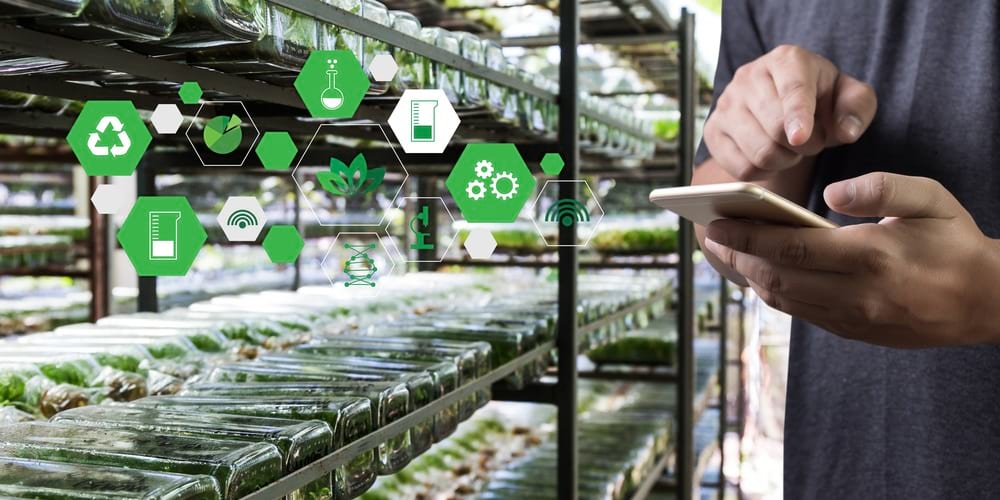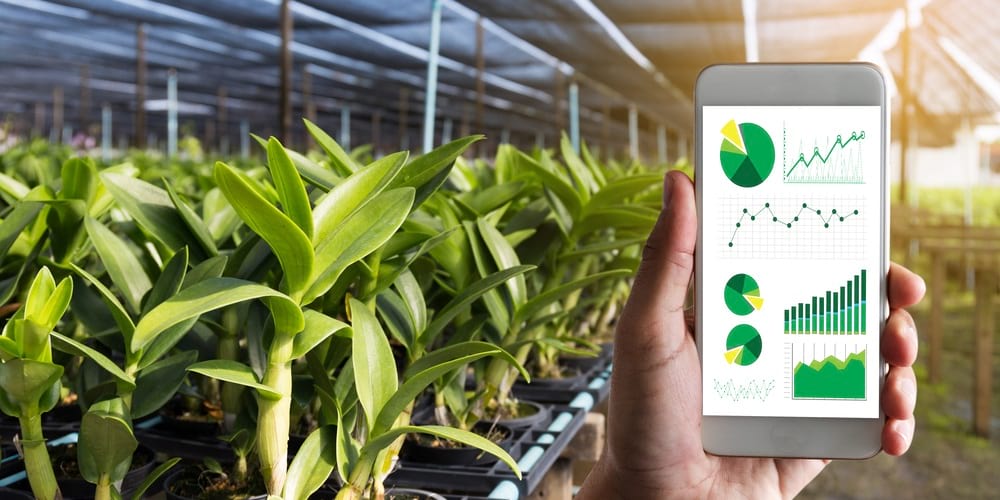The Internet of Things (IoT) is a network of devices linked with sensors, software, and other technologies that send data and information across the internet.
Wireless sensors, software, actuators, and computer devices are all examples of IoT components. They connect via the internet, allowing data to be transmitted between objects or people, automatically, without human intervention.
» FREE TRIAL: Launch Your IoT Application To Market in Less Than 30 Days with Ubidots Drag-n-Drop IoT Dashboards
For example, your smart refrigerator might get an alert sent to its screen if the door is left open or if there’s been no activity for an extended period.
IoT devices collect large amounts of data about their environment—weather conditions, traffic patterns, human behavior, and other factors—and they all play into the accuracy of this technology’s analysis capabilities.
How and where IoT sensor data is used varies greatly based on the need. For example, sensors used in farming can help farmers determine the effectiveness of the fertilizers being used.
Alternatively, for livestock farmers, IoT sensor data analysis can be used to watch animal behaviors such as eating patterns and sleeping cycles, which signal illness or stress levels.
By tracking these key factors with IoT sensors, farmers can detect and address problems early on and increase the overall efficiency of their operation.
There are a myriad of sensor types used in the IoT world and their function varies on the basis of the data they capture and digitize.
1. Temperature Sensors
Temperature sensors detect temperature changes and convert these variations into data. In factories, temperature controls often decide the fate of a product. Likewise, in food processing plants, wrong temperatures can often ruin an entire batch of goods.
Soil temperature is also an important factor for agricultural growth, as soil conditions affect plant development.
With IoT sensors in these facilities, temperature fluctuations are easily detectable and can be addressed quickly before they become problematic.

2. Chemical Sensors
Chemical sensors in any industry help track chemical leaks from drums or tanks throughout process lines with real-time data analysis.
These IoT sensors can also make sure that hazardous substances are handled safely and securely whenever they’re required for on-site use, thus creating a safer and more efficient plant environment.
3. Humidity Sensors
These sensors, often known as hygrometers, measure the amount of water vapor in the air or other gases. Humidity sensors are widely used in industrial and residential HVAC systems to watch and forecast the weather.
The data coming from humidity sensors can be used to adjust the production process depending on weather conditions.
This information helps determine the most efficient times to carry out certain processes: for example, based on humidity data, experts can know the ideal time to mix chemicals to guarantee there are no unforeseen reactions.

4. Solar Cells
IoT solar cell sensors in electric vehicle charging stations provide real-time data that are analyzed for load balancing between power systems.
They can activate or deactivate sources of renewable energy in order to meet demand, ensuring stable voltage, regardless of fluctuations in the grid.
5. Pressure Sensors
The level of pressure is analyzed through IoT pressure sensors. This information can be used to schedule cleaning or maintenance tasks at optimal times and can also be used to detect faults proactively.
Pressure sensors can sense pressure changes, and based on these changes, for example, an alert can be sent to the monitoring station whenever there is a leak in a vessel.
Pressure sensors are often used in medical devices such as blood pressure cuffs and respiratory masks to make sure the patients’ blood pressure matches with the numbers and that they are getting adequate airflow during treatment, respectively.
These sensors track interfaces between patients’ bodies with their equipment allowing medical professionals to access important health information at all times for better diagnosis and treatment of medical conditions.
6. Biomedical Sensors
IoT sensor data is used in the medical industry to provide early detection of illnesses and improve the monitoring of patients.
Wearable IoT sensors check patients’ vitals such as blood pressure and heart readings in real time in order to identify potential cardiovascular diseases or other health concerns that might impact a patient’s wellbeing.
7. Proximity Sensors
Proximity sensors are used to detect objects near the sensor without making physical contact with them. There are many different use cases for these types of sensors:
- Proximity Sensors in Retail: IoT sensors for retail can track customer traffic as well as the movement of products within the store, personal shopping habits, specific shelves, and product locations. Such sensor data provides critical information about how to optimize retail space planning.
- Proximity Sensors in Smart City Planning: Planners can use proximity sensors to predict traffic patterns and electrical usage based on proximity. Moreover, these sensors can also plan parking availability.
- Proximity Sensors in Manufacturing: IoT sensors for manufacturing track objects such as machine parts, tools, and other products as they move throughout a factory. These IoT sensors can even provide up-to-date information about the status of each product directly to the consumer.
- Proximity Sensors in Smart Buildings: IoT sensors installed in smart buildings help make people’s lives easier and preserve the environment around them as well. Another use is that of motion-sensor lights that turn on based on movement and help reduce energy consumption. Also, IoT sensors can be used to track occupancy and help determine temperature settings, and can even be used to detect whether people are present in the office for security purposes.
8. Gyroscope sensors
A gyroscope is a rotating device that creates its own magnetic field. It’s used in a variety of gadgets, including cell phones and automobiles.
In vehicles, for example, gyroscope sensors can detect changes in direction, speed, and acceleration along with their relative location. They can also determine if a vehicle has changed lanes, slowed down, or stopped on the road, which helps create more efficient driving routes.
Gyroscope sensors analyze the angular rate or velocity, usually defined as a measurement of speed and rotation around an axis.
9. Cameras and Optical Sensors
Farmers can use unmanned aerial vehicles (UAVs) equipped with high-definition cameras to capture images of crops from above. This data can be used to identify issues with growing conditions that could lead to crop failure before it’s too late.
Smart cars can also employ optical sensors to identify environmental and traffic conditions that can affect vehicle movement. These sensors are constantly scanning the roadways, identifying any debris or poor road conditions that might require changing course in order to avoid harm to the vehicle or its occupants.
10. Gas and Air Quality Sensors
It’s difficult to measure air quality and other parameters like carbon monoxide levels without a machine’s assistance. Gas sensors can provide real-time data on CO2 concentrations so you know when to change out heating and ventilation systems or parts.
They also help identify other areas for improvement in order to meet the current environmental objectives.
11. Accelerometers
Aerospace companies use data from IoT sensors to track the performance of an aircraft. One of the IoT sensors used in planes is the accelerometer, which checks movement and g-forces during flight, providing a detailed record of a plane’s movements.
Accelerometers can also detect changes in gravity. They are being used in a variety of applications, including smart pedometers and tracking vehicle fleets. They may also be employed to notify the system if an object that should be stationary moves, as an anti-theft protection measure.
Understanding How IoT Sensor Data is Used
Regardless of the type of sensor, data is used to improve future iterations of a product or piece of equipment. A key goal of any IoT system is to detect issues before they become serious, saving time and money in the long run.
It’s useful to think about data generated by a device in three steps.
The initial process, which takes place on the device and is then transmitted over the Internet, can be considered the first step.
The second step is how that information is gathered and organized. Sensor datasets are typically housed within the cloud, with users paying for access based on how much data they want to store.
It’s really only in step three that the data is analyzed and inferences are made for future reference.
Ubidots and IoT
Ubidots is the IoT platform for businesses and developers alike. Tracking IoT sensor data with Ubidots and their intuitive tools will quickly help you gain key insights from your data and transform it into powerful analytics.

Ubidots is the leading IoT platform for businesses and developers with thousands of customers worldwide in a wide range of industries. It enables users to quickly connect sensors to track data in real-time or pass that data on securely to applications where you can gain actionable insights from the collected sensor data.
Contact us to learn more about how Ubidots can help you embrace the power of IoT for your business and your customers.
Originally published 18 Nov 2021
Frequently Asked Questions
What is IoT sensor data?
IoT sensor data is the data collected by devices found in the Internet of Things (IoT). These devices can be anything from a thermostat in a device to a car. The internet part of IoT means that these devices can connect, collect, and send data across networks where it can be analyzed and acted upon.
What data do IoT sensors collect?
Sensor data can vary and multiple devices collect different types of data. Devices can measure anything from temperature, numbers of individuals in a room, activity levels, and how much water is in the soil.
How do IoT sensors send data?
IoT sensors are typically small with low-energy usage so that they can last for years without needing any extra power source such as batteries. Data can be sent wirelessly or through a network connection.
What can IoT sensors measure?
Sensors can collect an immense amount of information about their surroundings, such as:
- Temperature (indoor and outdoor) & humidity
- Light (ambient and darkness), UV rays, and lux/illuminance measurements, i.e., a light sensor
- Air quality including CO2, Ozone, Volatile Organic Compounds (VOCs), and Particulate Matter (PM)
- Water Quality, i.e., a water quality sensor for wastewater
- Soil moisture, i.e., a soil moisture sensor
- Counting/monitoring, i.e., plant population in controlled environments such as greenhouses or nurseries
- Acceleration, i.e., to measure the impact of bodily collisions with hard objects; i.e., a crash test dummy monitor
- Motion, i.e., to track movement, and much more.

